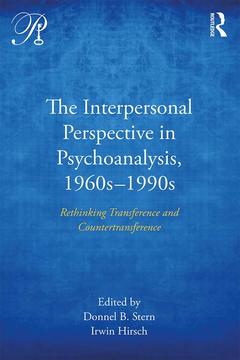Description
The Interpersonal Perspective in Psychoanalysis, 1960s-1990s
Rethinking transference and countertransference
Psychoanalysis in a New Key Book Series
Coordinators: Stern Donnel B., Hirsch Irwin
Language: English
Subject for The Interpersonal Perspective in Psychoanalysis, 1960s-1990s:
Keywords
Young Man; Psychoanalysis; William Alanson White Institute; interpersonal; Participant Observation Model; relational; Benjamin Wolstein; Harry Stack Sullivan; Transference Countertransference Field; Edgar Levenson; Interpersonal Paradigm; Frieda Fromm-Reichmann; Ernest Schachtel; Harold F; Searles; Erwin Singer; Interpersonal Psychoanalysis; Interpersonal Analysts; Edgar A; Levenson; Analyst’s Participation; David E; Schecter; Interpersonal Writers; Joseph Barnett; Analytic Anonymity; Jay R; Greenberg; Patient’s Illness; Darlene Bregman Ehrenberg; Swiss Cheese; Merton M; Gill; Vice Versa; Stephen A; Mitchell; Unwitting Participation; Irwin Hirsch; Relational Psychoanalysis; Philip M; Bromberg; Psychoanalytic Engagement; Experiential Knowing; Sullivan’s Position; Baltimore Washington Institute; Isakower Phenomenon; Implosive Characters; EEG Evidence
Publication date: 02-2017
· 15.6x23.4 cm · Paperback
Publication date: 02-2017
· 15.6x23.4 cm · Hardback
Description
/li>Contents
/li>Readership
/li>Biography
/li>
North American psychoanalysis has long been deeply influenced and substantially changed by clinical and theoretical perspectives first introduced by interpersonal psychoanalysis. Yet even today, despite its origin in the 1930s, many otherwise well-read psychoanalysts and psychotherapists are not well informed about the field. The Interpersonal Perspective in Psychoanalysis, 1960s?1990s provides a superb starting point for those who are not as familiar with interpersonal psychoanalysis as they might be. For those who already know the literature, the book will be useful in placing a selection of classic interpersonal articles and their writers in key historical context.
During the time span covered in this book, interpersonal psychoanalysis was most concerned with revising the understanding of the analytic relationship?transference and countertransference-and how to work with it. Most of the works collected here center on this theme. The interpersonal perspective introduced the view that the analyst is always and unavoidably a particular, "real" person, and that transference and countertransference need to be reconceptualized to take the analyst?s individual humanity into account. The relationship needs to be grasped as one taking place between two very particular people. Many of the papers are by writers well known in the broader psychoanalytic world, such as Bromberg, Greenberg, Levenson, and Mitchell. But also included are those by writers who, while not as widely recognized beyond the interpersonal literature, have been highly influential among interpersonalists, including Barnett, Schecter, Singer, and Wolstein.
Donnel B. Stern and Irwin Hirsch, prominent interpersonalists themselves, present each piece with a prologue that contextualizes the author and their work in the interpersonal literature. An introductory essay also reviews the history of interpersonal psychoanalysis, explaining why interpersonal thinking remains a coherent clinical and theoretical perspective in contemporary psychoanalysis. The Interpersonal Perspective in Psychoanalysis, 1960s?1990s will appeal greatly to psychoanalysts and psychoanalytic psychotherapists wanting to know more about interpersonal theory and practice than can be learned from current sources.
Introduction: Interpersonal Psychoanalysis: History and Current Status
Chapter 1: Searles, H. F. (1967/1979). The "Dedicated Physician" in the Field of Psychotherapy and Psychoanalysis.
Chapter 2: Wolstein, B. (1975). Countertransference: The Analyst’s Shared Experience and Inquiry with His Patient.
Chapter 3: Singer, E. (1977). The fiction of analytic anonymity.
Chapter 4: Levenson, E. (1978). Two Essays in Psychoanalytical Psychology: Psychoanalysis: Cure or Persuasion?
Chapter 5: Schecter, D.E. (1980). Early Developmental Roots of Anxiety.
Chapter 6: Barnett, J. (1980). Interpersonal Processes, Cognition, and the Analysis of Character.
Chapter 7: Greenberg, J. (1981). Prescription or Description: The Therapeutic Action of Psychoanalysis.
Chapter 8: Ehrenberg, D.B. (1982). Psychoanalytic Engagement—The Transaction as Primary Data.
Chapter 9: Gill, M. (1983). The Interpersonal Paradigm and the Degree of the Therapist’s Involvement.
Chapter 10: Mitchell, S. (1988). The Intrapsychic and the Interpersonal: Different Theories, Different Domains or Historical Artifacts?
Chapter 11: Hirsch, I. (1990). Countertransference and Participant-Observation.
Chapter 12: Stern, D.B. (1990). Courting Surprise—Unbidden Perceptions in Clinical Practice.
Chapter 13: Bromberg, P.M. (1994). "Speak! That I May See You": Some Reflections on Dissociation, Reality, and Psychoanalytic Listening.
Donnel B. Stern is Training and Supervising Analyst at the William Alanson White Institute in New York City and Adjunct Clinical Professor of Psychology on the New York University Postdoctoral Program in Psychotherapy and Psychoanalysis. He is the founder and editor of the Routledge "Psychoanalysis in a New Key" book series and author of many psychoanalytic articles and books, the most recent of which is Relational Freedom: Emergent Properties of the Interpersonal Field.
Irwin Hirsch supervises and/or teaches at the Manhattan Institute for Psychoanalysis; the William Alanson White Institute; the NYU Postdoctoral Program in Psychotherapy and Psychoanalysis and the National Institute for the Psychotherapies, National Program. He has authored over 80 journal articles and book chapters and two books: Coasting in the Countertransference: Conflicts of Self-Interest between Analyst and Patient, winner of the Goethe Award; and The Interpersonal Tradition: The Origins of Psychoanalytic Subjectivity.




